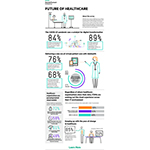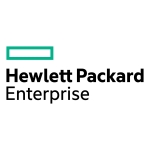HPE Survey Finds 76% of Doctors and Nurses Believe Telehealth Will Dominate Patient Care in Near Future

- To keep up with the pace of change, 85% of IT decision makers (ITDMs) say IT modernization is one of the biggest drivers when investing in their IT environments
- More than 80% of ITDMs believe connected medical devices will have a significant impact on their organization in the next five years
- 61% of ITDMs say they are pursuing a hybrid cloud strategy, and 58% cited data egress costs as one of the most essential factors in deciding where to store data
HOUSTON–(BUSINESS WIRE)–As global healthcare teams continue to adjust to a digital-first future for delivering patient care, Hewlett Packard Enterprise (NYSE: HPE) today unveiled survey data that reveals how the healthcare industry is going through a rapid transformation, with a profound impact on the technologies and solutions required to meet the demands of modern, scalable healthcare delivery. These findings are presented in HPE’s first ever, multi-country HPE “Future of Healthcare” Report which surveyed healthcare clinicians and IT Decision Makers (ITDMs) in the United States and United Kingdom.
Market research firm Vanson Bourne conducted the HPE-sponsored survey to explore respondents’ perceptions on how the pandemic has impacted technology in their healthcare organization, opportunities and challenges related to the COVID-19 pandemic, artificial intelligence (AI), edge technologies, hybrid cloud, machine learning (ML), and telehealth. The findings point to an increased focus and investment in solutions that can help healthcare organizations future-proof their edge-to-cloud IT environments and ensure agility and flexibility in the ways they deliver quality patient care at scale, regardless of where the providers and patients may be located.
“The healthcare industry has undergone tremendous change over the last 18 months, enabling providers to connect with their patients securely and effectively wherever they are, with virtual care at the forefront,” said Steve Cotham,Healthcare Chief Technologist at HPE. “In this new paradigm of modern healthcare, however, organizations face compounding pressures to quickly adapt while still making progress toward long-term business, data management, and patient care objectives. As a result, they are seeking out agile, scalable, secure, and cost-effective platforms that serve their entire edge-to-cloud environment, while still meeting the requirements of an increasing regulatory healthcare landscape.”
The COVID-19 pandemic was a catalyst for digital transformation
According to Gartner, the number of telehealth visits increased by 154% in the last week of March 2020 compared to the same timeline in 2019.1 The sudden shift to accelerate digital transformation saw healthcare providers change focus to innovation and modernization, and prioritizing the cloud experience in their investments. Data from HPE’s Future of Healthcare Survey shows 84% of ITDMs agree the pandemic has accelerated their organization’s digital transformation. An additional 89% agree the pandemic has made investing in new technologies a priority for their organization.
Delivering a new era of virtual patient care with telehealth
With the rapid growth of edge technologies, edge computing is being used to monitor patients remotely, automate the delivery of care, leverage artificial intelligence (AI) to improve the speed and accuracy of diagnoses, and more. The COVID-19 pandemic sparked a huge increase in telehealth adoption, enabling healthcare organizations to continue to provide patient care outside of traditional healthcare settings. Still, 68% of clinicians agreed they “frequently have issues in delivering telehealth” to patients due to lack of access to the right technology or networks, highlighting the challenges that remain as the digital divide prevents widespread access to wi-fi connectivity and technology around the world.
Demonstrating the increased value of breakthrough edge technologies in the past year, more than three-fourths (82%) of ITDMs believe connected medical devices are one of the technologies that will have the biggest impact on their organization in the next five years. A further 55% say remote working has become more important to their organization’s IT department in the last 12 months. This demonstrates the importance of a fast, efficient edge network where the delivery of quality patient care remains the top priority.
“The survey results indicate healthcare’s interest in deploying AI to deliver better clinical outcomes,” said Dharmendu Damany, Chief Technology Officer at Carestream. “Carestream has been a leader in leveraging powerful AI technology to help improve image quality, optimize dose and increase workflow efficiency in medical imaging. Now we are accelerating the pace of our development by providing our industry-leading medical imaging scientists with the optimal AI platform/framework for their research. Our partnership with HPE and their industry leadership with HPE GreenLake Cloud Services gives us the framework to support the operationalization of AI to deliver more solutions that can help improve diagnosis and patient care.”
Healthcare organizations are pursuing hybrid cloud models
Today’s healthcare organizations operate in an edge-to-cloud world. Many have determined their applications and workloads must remain on-premises or at the edge due to cost, compliance, control, latency, security, and compliance considerations. For example, 72% of ITDMs cited IT security as the primary concern when moving all of their organization’s data to the public cloud, and 58% cited data egress costs – the charges associated with moving data out of the cloud – as one of the most essential factors in deciding where to store data. As a result, almost two-thirds (61%) of ITDMs say they are pursuing a hybrid cloud strategy.
“Faced with the rapid rate of change sparked by the COVID-19 pandemic, healthcare organizations are undoubtedly favoring hybrid IT models,” said Jo Peterson, Vice President, Cloud and Security Services at Clarify360. “The flexibility offered by hybrid environments means healthcare organizations can have fast and easy access to patient data, they can focus on specific security and compliance mandates, define the most cost-effective strategy for their data, and tailor a business continuity plan suited to their specific needs.”
As ITDMs look to optimize their edge-to-cloud IT environment to improve performance and efficiency, 48% of ITDMs said adopting new and emerging IT cloud platforms was one of the most significant drivers when investing in IT infrastructure. Regardless of where they store their data, ITDMs are seeking out the cloud experience with a majority (55%) surveyed pointing to “self-service IT” as one of the top features for their IT environment in terms of having on-demand access to IT services, applications, and scale.
Other key findings of this year’s report include:
- 79% of ITDMs say delivering better clinical outcomes (genomics, patterns, medical imagining analysis, etc., via massive amounts of data being collected) is one of the most important outcomes in deploying AI or ML in their organization
- 53% of ITDMs said IT skills is a key enabler of innovation in their organization
- 61% of ITDMs cite better data security as a key benefit of investing in edge technologies
- Just 5% of ITDM respondents said the pandemic has had no impact on their organization’s digital transformation long-term
HPE for Healthcare
HPE serves thousands of healthcare organizations worldwide and has delivered solutions to healthcare and life sciences for decades, providing the right technologies and expertise to help deliver transformative outcomes. HPE aims to improve health and community well-being through technology and health information that is accessible whenever and wherever it matters most, including enabling secure and reliable access to patient records, protecting and mobilizing medical imaging data, and accelerating medical insight and scientific discovery. https://www.hpe.com/us/en/solutions/Healthcare.html
The HPE GreenLake edge-to-cloud platform is uniquely suited to address the agility, compliance, and data requirements of the healthcare industry’s rapid transformation. The HPE GreenLake cloud platform combines the simplicity and agility of the cloud with the governance, compliance, and visibility that comes with hybrid IT. HPE GreenLake platform offers a range of cloud services that accelerate innovation, including cloud services for Epic Inc. electronic medical records, and virtual desktop infrastructure (VDI) for remote workforces. With customers such as Carestream, Prisma Health, University Hospital of Bonn, and Tübingen University, HPE GreenLake is helping to redefine clinical experiences and accelerate the way providers deliver healthcare around the world. https://www.hpe.com/us/en/greenlake/healthcare.html
Survey Methodology
Conducted from April to May 2021, HPE and Vanson Bourne surveyed 400 healthcare IT decision-makers (150) and patient-facing healthcare professionals (250) in the US and UK using online surveys. All respondents work in healthcare organizations with at least 500 employees.
About Hewlett Packard Enterprise
Hewlett Packard Enterprise is the global edge-to-cloud platform as-a-service company that helps organizations accelerate outcomes by unlocking value from all of their data, everywhere. Built on decades of reimagining the future and innovating to advance the way people live and work, HPE delivers unique, open, and intelligent technology solutions, with a consistent experience across all clouds and edges, to help customers develop new business models, engage in new ways, and increase operational performance. For more information, visit: www.hpe.com.
1 Gartner, Telehealth Takes Over, Anshuman Rathore, Apr 19, 2021 (GARTNER is a registered trademark and service mark of Gartner, Inc. and/or its affiliates in the U.S. and internationally and is used herein with permission. All rights reserved.)
Contacts
Ainslee Shea
ainslee.shea@hpe.com

